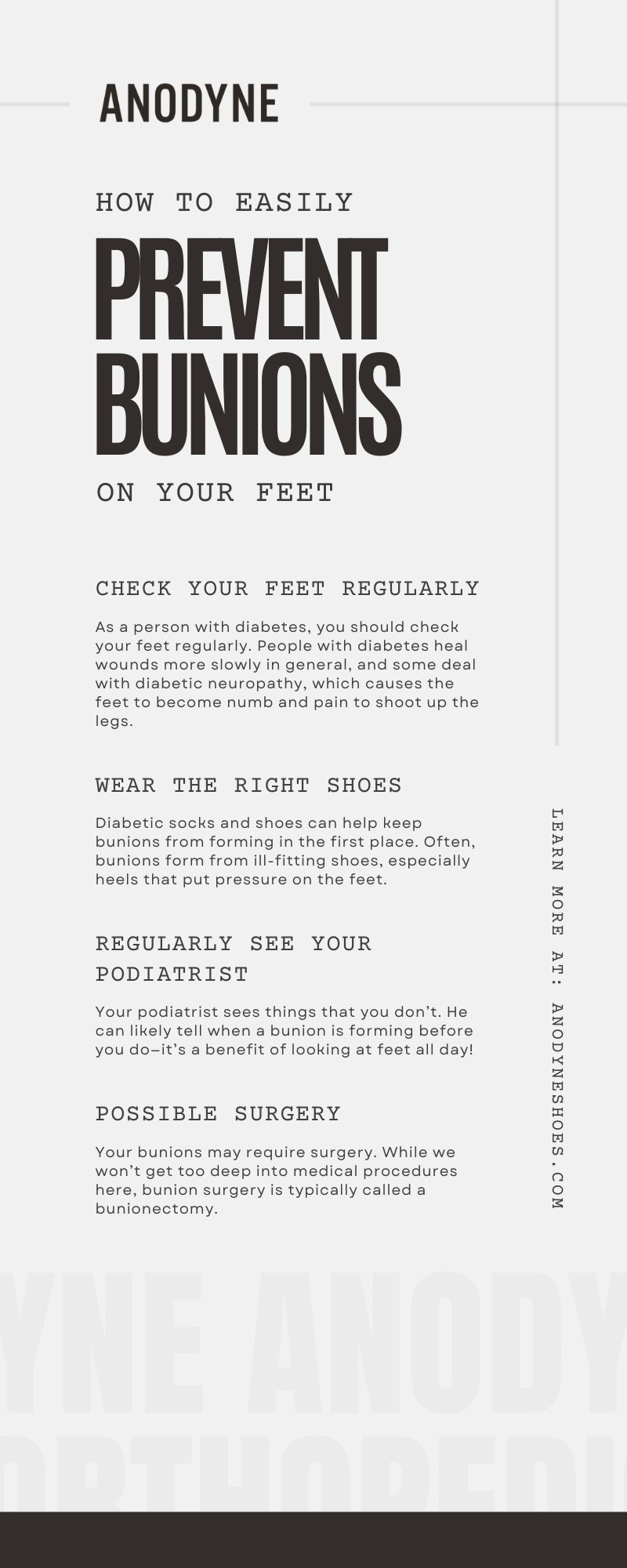-1.jpg?width=750&height=422&name=Blog%20Template%20copy-1%20(11)-1.jpg)
Bunions are a painful condition many adults deal with and individuals with diabetes are especially susceptible to them. It’s important to understand what bunions are and how you can prevent them. Read on to learn how to prevent bunions on your feet below.
What Are Bunions?
Bunions are a common foot problem that mostly affects adults. A bunion is a bony bump on the joint between your big toe and the second digit. Unfortunately, they cause your big toe to move inward toward your smaller toes since the bump forces the joint at the base of your toe to stick out at an exaggerated angle. In some cases, this can cause immense pain over time, but some people don’t feel anything at all.
What Are Some Symptoms?
Some symptoms of bunions include an uncomfortable bulging bump between your big and smaller toe. It’s usually swollen and red. It also causes the rest of the joint to redden due to friction. In many cases, corns and callouses also grow at the site. Since the two toes are so close together, they often cause friction.
You might feel the bunion throbbing at night and getting progressively worse. People often experience shooting pain toward the ball of their foot depending on where the joint is situated. If you have any of these symptoms, you might want to head to your general practitioner or podiatrist for confirmation.
Prevention
There are many ways to prevent bunions from forming. Symptoms can creep up over time—even over the years—so preventative care may be ongoing, especially when you struggle with diabetes. Here are some preventative measures you can take today:
Check Your Feet Regularly
As a person with diabetes, it’s important check your feet regularly. In general, individuals with diabetes wounds heal more slowly. Some diabetics deal with neuropathy, which causes the feet to become numb and pain to shoot up the legs. As such, it might be harder for you to feel a bunion forming if your feet are already numb. If you inspect your feet daily, however, you might notice that your big toe is angled in an odd direction or that there is friction where there normally isn’t any.
Wear the Right Socks
Diabetic socks are key in protecting your feet. They also help with circulation, which can let your toes breathe. Socks can also provide the first layer of defense with cushioning that protects the bunion from the shoe around it. The last thing you want to do is walk around in your bare feet if you have diabetes (we’ll get into why that’s detrimental in the next section.) Socks provide you with the protection you need to prevent bunions from forming and allow current bunions to heal. You can even wear diabetic orthopedic shoes or slippers to protect you further.
Wear the Right Shoes
Wearing the right shoes is essential for anyone with diabetes. Podiatrists even recommend that you walk around inside the house with shoes since you are subject to cuts and other wounds throughout the day. As we mentioned earlier, with diabetic neuropathy, it may be difficult to determine whether you have a wound. In cases like this, wearing shoes everywhere you go is a good form of protection.
Diabetic socks and shoes can help keep bunions from forming in the first place. Often, bunions form from ill-fitting shoes, especially heels that put pressure on the feet. Heels are a no-go for people with diabetes because they can cause unwanted pressure and poor circulation, and bunions are a common side effect.
Use Inserts
Since bunions are caused by improper biomechanics, most podiatrists recommend some form of insoles to provide bunion support. These also are ideal for individuals with plantar fasciitis, edema, heel pain, etc. Getting diabetic shoe inserts should prevent bunion development and correctly position the foot. Make sure you find one customized for you that shapes to the contours of your feet, and you’ll be well on your way to preventing bunions.
Regularly See Your Podiatrist
Your podiatrist sees things that you don’t. He can likely tell when a bunion is forming before you do—it’s a benefit of looking at feet all day! Of course, as a person with diabetes, it’s important to work with your podiatrist since they can alert you of an issues early on to avoid future conditions. If you have bunions already, you may be able to get some salient advice on how to manage it from your podiatrists, such as icing procedures and possible inserts you can purchase. Overall, visiting your podiatrist is a perfect failsafe, and if you have any wounds or callouses, you should probably visit them sooner rather than later.
Possible Surgery
Your bunions may require surgery. While we won’t get too deep into medical procedures here, bunion surgery is typically called a bunionectomy. There are multiple techniques, but usually, it involves cutting bones apart and repositioning them with metal screws. This straightens the big toe and repositions it so that it no longer deals with friction. From there, it can heal effectively.
Do Foot Exercises
There are many exercises you can do for bunions. Work with toe points and curls by sitting on a surface with your feet 6 inches from each other. Point and curl your feet repeatedly for about 15 to 20 reps, 3 to 4 sets each. Toe spreads can be done while sitting. You put your feet on the floor, lift them off the ground, and spread your toes. You’ll want to do these 10 to 15 times on each foot.
Toe circles help mitigate stiffness; this is perfect for after you’ve had a long day and are about to turn in for the evening. For this exercise, sit on a chair, lean over, and grab your big toe. Circle the toe clockwise and then counterclockwise 20 times each. Beyond just being an excellent toe stretch, it can also stretch your back. Regular exercise is a great way to prevent bunions on your feet.
In short, bunions don’t have to impede you. At best, they’re easily preventable. At Anodyne, we offer diabetic footwear and accessories designed to help you! Shop Anodyne products today! If you have any more questions on, "How can you prevent bunions? Tips for preventing bunions!", contact us!



.png?width=116&name=Anodyne_circle_1_logo%20(2).png)
